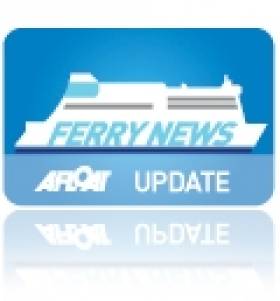Displaying items by tag: Finnarrow
Stena Send in ‘Freight-Only’ Ferry to Replace Damaged Chartered Ferry
#FerryBackUp – Freight ferry Stena Scotia (1996/13,017grt) docked in Dublin Port yesterday for 'berthing trials' and is to provide extra capacity for freight customers next week, writes Jehan Ashmore.
She is a replacement to the damaged chartered ferry Finnarrow, which as previously reported has since reached Scotland, with a tug berthing in Greenock.
The Dutch flagged Stena Scotia (capacity: 114 trailer units) will start freight-sailings next Monday (25 February) to Holyhead, where the 12-driver-accompanied vessel had called en-route yesterday also for berthing trials, having made an overnight passage from Belfast.
It was at the Anglesey port last weekend, where an incident involved the Finnarrow's stabilisers that led to cancelled sailings.
Stena Scotia will run in tandem with ro-pax Stena Adventurer (which takes passengers) on the Dublin route. There will also be additional passenger back-up with fastcraft HSS Stena Explorer sailings on the Dun Laoghaire-Holyhead route.
All passengers are advised to call Stena Line ferrycheck number 08705 755 755, for the most up-to-date information on sailings for 'foot' and those that are 'vehicle-only' by clicking this LINK.
The other regular Dublin route serving ro-pax Stena Nordica is as previously reported on refit cover on the North Channel and is expected to return to service on 19 March.
Stena Scotia (and sister 'Hibernia') had been lying idle in Belfast since September, having been replaced by larger chartered tonnage in the form of newbuild sisters, Stena Performance and Stena Precision.
The pair (from a quartet of newbuilds built last year) operate Stena's Belfast-Heysham freight service, following a short career starting off on the Irish Sea for operators Seatruck.
She has seen a succession of name changes in recent years, as Scotia Seaways under the navy blue colours of DFDS Seaways during a brief entry into the Irish Sea market in 2010.
Before that, she sported the pale blue livery scheme under Maersk / Norfolkline North Sea service as the Maersk Exporter completed in 1996.
Stena Line to Reactivate HSS Service Following Ferry Incident
#FerryDisruption - According to ITV Wales, there was an incident on board the Finnarrow, a ferry on charter to Stena Line, while berthing in Holyhead at the weekend.
Stena Line has confirmed the incident at the Welsh port on Saturday, occured as the ferry was berthing after a sailing from Dublin Port, which involved the ships stabilisers. All 77 passengers and 43 crew were evacuated and the vessel was safely berthed.
The vessel is currently docked in Holyhead undergoing inspections and will remain out of service for the immediate future. Since then sailings by the Finnarrow have been cancelled.
Passengers due to travel on Stena Line's Holyhead-Dublin Port route also operated by the Stena Adventurer, will be accommodated on alternative sailings.
Afloat.ie adds that the HSS fastcraft Stena Explorer is to make an earlier than expected return to the Dun Laoghaire-Holyhead route tomorrow (19 February) so to cover the chartered Finnarrow's sailings, until further notice.
The HSS fastcraft will operate a daily single round-trip service, departing Holyhead at 10.30hrs and from Dun Laoghaire departing at 15.05hrs.






























































